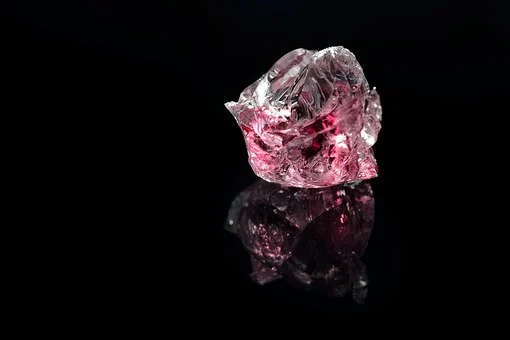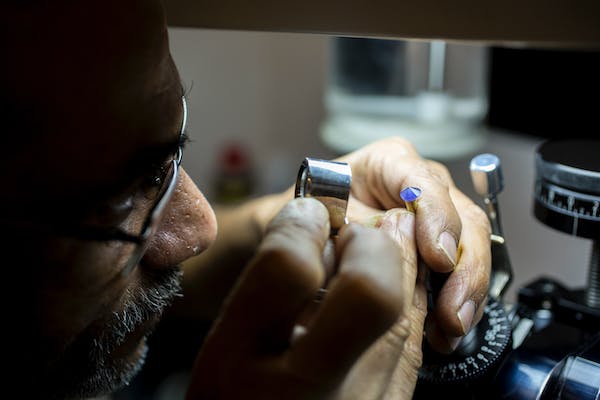When you think about engagement rings, you might picture emeralds and diamonds perched atop gold or platinum settings. While these are the most well-known gemstones ever, others are equally stunning and make for one-of-a-kind jewels. Colored gemstone engagement rings, such as those containing rubies, sapphires, and emeralds, are currently popular.
But more and more brides-to-be are searching for something unique, eye-catching, and distinctively different. This indicates that they are looking for rare jewels that aren’t displayed in a typical jeweler’s window. There are some incredibly rare and even more stunning-colored gemstones that you won’t find easily, and if you do, be prepared to shell out at least five figures per carat – and among them is taaffeite, one of the world’s rarest jewels.
What is Taaffeite?
Taaffeite is a translucent gem with a vitreous luster and is made of beryllium, magnesium, and aluminum as its primary elements. Taaffeite is doubly refractive in contrast to spinel, which is only singly refractive. It is frequently given a cushion or brilliant cut and has a vitreous shine. From delicate mauve, rose red, and ruby-red through violet, sapphire, gray-blue, pure blue, chestnut, and nearly colorless, taaffeite is available in a variety of hues. Taaffeite is only utilized as a gemstone because of how rare it is.
Taaffeite’s Meaning
For the select individuals who are fortunate enough to find it, taaffeite has a unique significance. Taaffeite’s fundamental significance is that it serves as a jewel that is both balanced and invigorating. Taaffeite boosts energy and provides luck and fortune. It is also thought to re-energize. Health and love are optimized with this gemstone. Its special qualities are thought to turn bad luck into good luck. It gives one a chance at fresh possibilities. Taaffeite serves as a talisman and an energy booster to assist the greatest outcomes.
Taaffeite’s History
Count Taaffe of Dublin, Ireland, made the initial accidental discovery of taaffeite in 1946. The Count picked up the stone from some trash in a coworker’s workshop and noticed that it was doubly reflective. Although the gem had the appearance of spinel, the count could tell that he had found something exceptional because spinel is only singly refractive. Count Taaffe submitted the sample to the London Gemstone Testing Laboratory and subsequently to the Natural History Museum for examination because he was unable to examine the stone himself. A little piece of the stone was removed and brought to the Natural History Museum for x-ray scanning. The stone was named after its discoverer at this point and was acknowledged as a brand-new, unidentified mineral.
Where Did Taaffeite Originate?
Taaffeite is quite uncommon. It comes from Sri Lanka, Southern Tanzania, and Myanmar. Parts of China and Russia have also been found to have taaffeite of lower value. Taaffeite is frequently found in minerals such as mica, spinel, tourmaline, fluorite, and others. It can be found in carbonate rocks, one of which is limestone. It can also be found in alluvial formations.
How Rare Is Taaffeite?
Only three samples of taaffeite were known to exist until the 1980s. However, it was discovered in 2002 that there were only about 50 gemstones in circulation. While the first taaffeite found weighed only 1.4 carats, a 13.5 carat stone was sold at auction in 1999. Even though this is the largest known sample of taaffeite, there have been rumors of a few gems that weigh between 7 and 9 carats being traded. A 10.33-carat mauve oval, the only flawless gem known to exist, is likewise owned by a Sri Lankan collector. There are currently only a dozen faceted red taaffeites in existence, making the red variety especially rare.
Taaffeite: Is It Good or Bad for an Engagement Ring?
Engagement rings should last a lifetime. To be passed down to the next generation, a gemstone needs to be long-lasting and secure in its setting. They shouldn’t sustain damages over time while doing your daily tasks. Here are a few points to consider if you want a taaffeite gemstone on your engagement ring.
- The translucent gem taaffeite has a lustrous sheen and comes in a variety of colors.
- Taaffeite is a relatively hard stone with a rating from 8 to 8.5 on the Mohs scale. Because of its relative hardness, it won’t easily break if used as an engagement ring stone.
- Since gem collectors purchase most of these gemstones, taaffeite jewelry is very hard to find. Your best option if you really must have a taaffeite ring or necklace is to purchase a loose gemstone or even crystal and have it cut and set in the jewelry of your choice.
- High-quality pieces are, however, uncommon, and hence expensive, as is the case with most gemstones. Because a lot of the material has a lighter saturation, it can also be found for a reasonable price, ranging from about $1,500 to 2,500 per carat.
- There aren’t any known taaffeite improvements or knockoffs currently. Probably because only collectors are familiar with this stone and are less likely to be duped by a fake or enhanced stone.
- Taaffeite is a rare gemstone, so you should speak with an expert gemologist about how to care for it in your engagement ring and other things you should know before buying. Simply said, there isn’t enough general knowledge available about this precious stone.
Conclusion
Taaffeite is remarkable for a variety of reasons. It’s the only one to have been found as a polished and faceted gem rather than one that came from a mine, making it one of the rarest gems ever. Because of its vitreous luster, it can be a magnificent choice for an engagement ring especially if you want something distinct but don’t want to spend a lot of money on a diamond. Although looking for one can be time-consuming and expensive, its longevity can be trusted. Even though you desire a special engagement ring stone, there are additional factors to take into account—not just for aesthetic value but also for your satisfaction.



